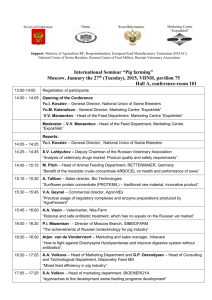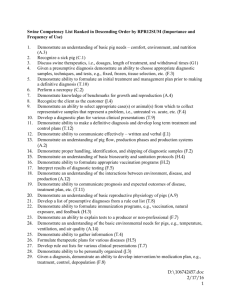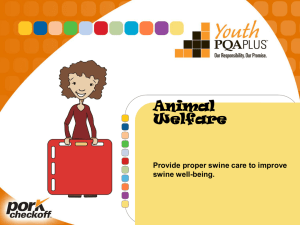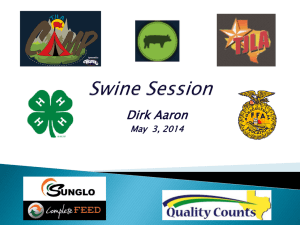Sarasota County Fair Swine Record Book
advertisement
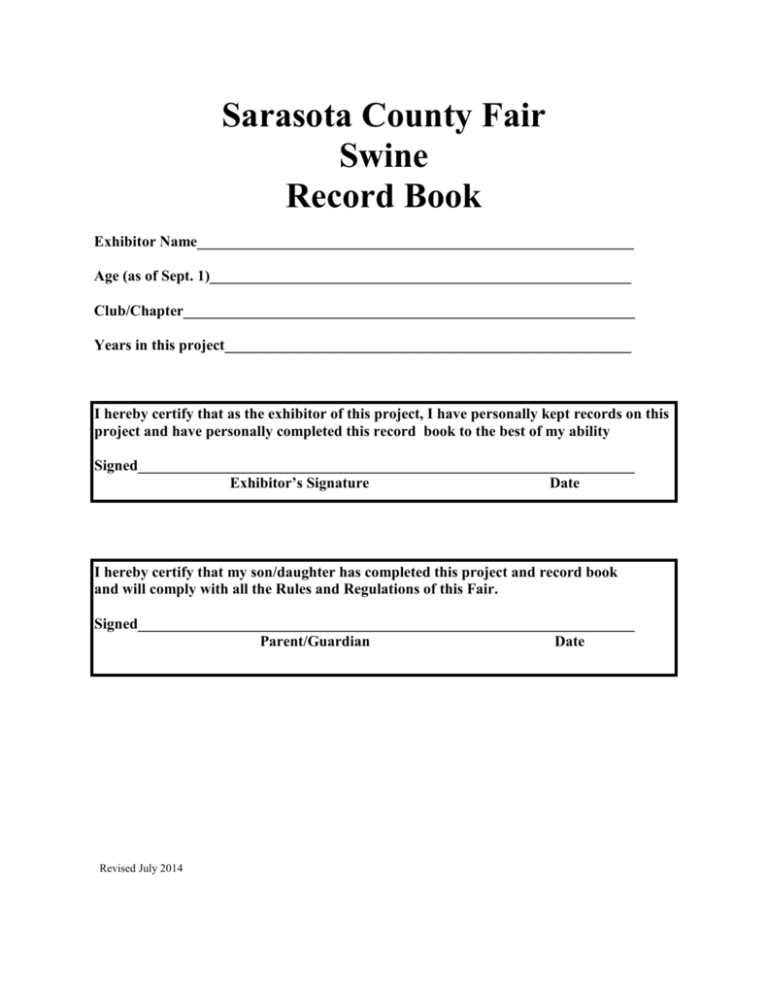
Sarasota County Fair Swine Record Book Exhibitor Name__________________________________________________________ Age (as of Sept. 1)________________________________________________________ Club/Chapter____________________________________________________________ Years in this project______________________________________________________ I hereby certify that as the exhibitor of this project, I have personally kept records on this project and have personally completed this record book to the best of my ability Signed__________________________________________________________________ Exhibitor’s Signature Date I hereby certify that my son/daughter has completed this project and record book and will comply with all the Rules and Regulations of this Fair. Signed__________________________________________________________________ Parent/Guardian Date Revised July 2014 Swine Exhibitor Project Agreement (NOTE: THIS PAGE MUST BE SIGNED AND VERIFIED BY FIRST WEIGH-IN) The youth is responsible for caring for the animal, which will include feeding, deworming, providing fresh clean water, providing a pen, and showing. The youth will use this project as an educational tool to learn skills needed in the livestock industry. This project will also help the youth to accept success and failure as a learning experience. The youth will keep accurate records on their project animal. I accept these responsibilities ___________________ Date ___________________________________________________ Signed - Exhibitor The parents are responsible for providing financial help if needed along with assistance and encouragement while the youth is raising this animal. We accept these responsibilities. ___________________ Date __________________________________________________ Signed - Parent / Guardian Drug Statement I hereby certify that any drug, antibiotic substance which may be administered by me, or any other person, will be done so in strict compliance with the manufacturer’s label requirements. _____________________________________________________________________________ Signature of Exhibitor Date _____________________________________________________________________________ Signature of Parent / Guardian Date The above signatures Verified by _______________________________________________ 4-H Agent/FFA Advisor Date (must be by 1st weigh-in) Purpose The purpose of a market animal project is to achieve the following: To acquire an understanding of the animal industry by preparing for, purchasing, caring for and keeping records on one or more head of animals. To be able to identify the types and breeds of animals and employ efficient methods of production and marketing. To understand the business aspects and economics of purchasing animals, feed, facilities and equipment for an animal project. To develop integrity, sportsmanship, and cooperation. To develop leadership abilities, build character, and become responsible citizens. 2 Performance Objectives of 4-H Swine Projects To aid in the development of young men and women into responsible American citizens by: Teaching responsibility through working with animals that depend on the members to provide proper feed and care. Teaching the value, use and management of money through its investments in animals, feed, equipment and receiving a return on its investment. Teaching sportsmanship and cooperation through participation in shows and working with other members. To help young people gain an appreciation for: The place of livestock in agriculture and its contribution to people. The importance of proper growth and development of market animals. To help young people gain skills in: Selecting the kind of animal that will make rapid, efficient gains and produce a high quality product. Feeding animals for optimum growth and proper development. Grooming and showing market swine. Keeping records. GENERAL INFORMATION At the initial weigh-in in December, You do not need a trailer certificate or health certificate. Your pig will be weighed if you request and given an ear tag for proper identification. When you bring your pig to the Fair in March, you will need a trailer certificate from your Veterinarian stating your trailer has been approved to haul your pig. Read your Fair rules and become familiar with the requirements to show your project, such as weigh-in times and dates, show dates and times, work day, etc. The ultra sound report will be posted in the downs Building (steer barn) after the final weigh- in . Ask your 4-H leader or Advisor how to do this if you are not familiar with the report. You will need this information to complete your record book. Weight: How To Weigh Your Pet Pig Without a Scale If you don’t have a scale, you can still weigh it by using the formula below. You will need a measuring tape . The formula is not exact, but it comes within about three percent of the actual weight. The formula is as follows: 1. Girth Measurement Take the heart-girth measurement. Your measuring tape needs to go around the body just behind the front legs and over the shoulder area. As an example for you I will use the measurements of Flower. Her girth measurement is 43 inches. 2. Square the result (Multiply the measurement by itself). Example: The measurement was 43 inches. 43 X 43 = 1,849. 3. Length Measurement: Measure the length of your pig. Start at the top of his or her head right in between the ears and measure down to the start, or base, of the tail (not the end of the tail). Try to have it’s head level. Flower's length is 39 inches. 4. Girth Result X Length: Take the girth measurement result (in the example above this was 1,849) and multiply that times the length of your pig. In our example this would be: 1,849 X 39 = 72,111. 5. Weight Calculation: Divide this result by 400, and you'll have a weight accurate to within about three percent. In our example: 72,111 divided by 400 = 180 pounds. Factoring in the 3% variance (5.4 pounds), this means Flower weighs between 174.6 and 185.4 pounds. 3 GENERAL MARKET HOG PERFORMANCE TRAITS Average Range Feed consumed per day - 40 pound pig 2.5 pounds 2.1-2.9 pounds Feed consumed per day - 150 pound pig 5.0 pounds 4.2-5.8 pounds Feed consumed per day - 240 pound pig 6.0 pounds 5.1-6.9 pounds Average daily gain 40 - 240 pounds 1.7 pounds/day 1.2-2.4 pounds/day Average Range Final live weight 245 pounds 210-280 pounds Length (first rib to aitch bone) pronounced H-bone or rump bone 30.5 inches 27.5-34.5 inches Tenth rib backfat 0.9 inches 0.3 - 1.5 inches Loineye area (10th rib) 5.5 square inches 4.0 - 9.0 square inches Yield (dressing percent) 74.5 percent 67.0 - 80.0 percent Carcass Traits: 245 - pound pig Your Project Performance Record Carcass data from the ultra sound reading is available after the final swine weigh in. It will be posted at the crows nest in the steer barn .Transfer the results to the corresponding line below. Final Live Weight _______ pounds Length (You must measure your hog before it is processed) _______ inches Tenth rib backfat _______ inches Loin eye Area _______ square inches 4 4-H Swine Project Guide Many 4-H'ers who have swine projects hope to raise a champion. While only one animal in a show is named champion, all exhibitors can benefit from the project. You will learn about the swine industry and how to produce a safe, wholesome product. The swine project is the largest livestock project in the state. Raising and showing a champion pig requires dedication, hard work and a little luck. Selecting a good animal, providing good facilities, developing a sound feeding and health program, learning showmanship and paying attention to details every day are all important. Overlooking any one of these areas can prevent you and your pig from making it to the fair. Selecting a good animal The importance of selection cannot be overemphasized. An animal’s genetics largely determine its growth, muscling and leanness. Youth exhibitors usually select their animals when the pigs are 8 to 10 weeks old and weigh 40 to 80 pounds. The challenge is to try to predict what a 50 to 70 pound feeder pig will look like at market weight, which is about 260 pounds or 6 months of age. If you are able to select the pig closer to 70 pounds, you will have a better chance of predicting how the animal will turn out. Successful show pigs should have an expressive amount of muscle and shape. Pigs should have a squareness and width in their top with a grove down the center. Another noticing feature is that the pig (when viewed from the rear) should have an hour glass appearance. This shape gives an indication of the muscle and leanness potential in the pig. The ham should be long, extending as far toward the hock as possible. Other indicators of future muscling is having a wide set to the hind legs, a flare or concave shape through the center of the ham, and a definite expression or bulging of muscle at the rump (ham-loin junction). The rump indicator is really important. Remember, a narrow set to the hind legs will not likely fill with adequate thickness and expression of muscle. As indicated earlier, a wide base was necessary for growth. When you are examining a prospective pig, step back from the pig about 10 to 20 feet and watch the animal walk and move. Pigs should take long strides and appear to be comfortable while walking. Many show pigs “goose step” or swing their feet in front of them before placing them on the ground. This is definitely something to avoid. Any problems that are apparent when a pig weighs 50 pounds will probably get worse by the time the animal reaches 250 to 270 pounds. 5 Nutrition and feeding management Genetics, nutrition, environment and the health of your pig will determine the animal’s growth rate. Most project pigs are fed a grower ration to a weight of 110 to 125 pounds and are then switched to a finishing ration to market weight. A pig’s protein requirements decreases as it grows and matures, consequently, commercial grower rations are higher in protein than finishing rations. In general, commercial rations are balanced to meet the needs of an average pig. Therefore, a pig that is above average for lean and muscle content may perform better if fed the higher protein grower ration to market weight instead of a finishing ration. Water is the most essential of all nutrients. If you use a nipple waterer, check it often to make sure the flow rate is right. Nipple waterers for grower to finish pigs (40 pounds to market weight) should provide 1 quart of water per minute. Fresh, clean water should never be withheld from an animal. Lack of water harms an animal’s health and also causes muscles to lose shape and expression, because muscle is made up of mostly water. How much should I feed my pig? How much should it gain? Pig Weight LB. /Day* Rate of Gain 40 -100 lb. 2.5 - 4.0 1.5 lb./day 100 - 160 lb. 4.0 - 6.0 1.75 lb./day 160 - 230 lb. 6.0 - 8.0 2.0 lb./day * Start with smaller amount and increase as animal gets larger. Deworming Deworm healthy pigs upon arrival and again a month later. Use a dewormer that is effective against whipworms, such as SafeGard (fenbendazole) at least once. Pigs suffering from diarrheal disease can be especially sensitive to deworming products. Safe-Gard is probably the least toxic product for pigs with diarrhea from whipworm infections. Ivomec (ivermectin) and Dectomax (doramectin) are excellent injectable dewormers that also kill lice and mange, but they are not always effective against whipworms. 6 General Record Book Guidelines It is suggested that a copy of the record book be made for use as a “Work Copy.” Records may then be transferred into this book for a “Final Copy.” 1. Your Record Book should begin when you purchase your animal. 2. You may place your Record Book in a folder or plastic protector sheets. (3 ring binders not recommended) 3. Have someone check your project story for spelling and grammar before you write it in the final record book. 4. Always double check your work, especially math calculations. 5. Your final record book must be handwritten by the exhibitor, preferably in pencil. Project Terms and Explanations 1. Project year - Based on a calendar year. Current project year is same year as current fair. 2. Date Acquired - List the date you obtained this item, on items older than 1 year, the year will be sufficient. 3. Purchase cost or value - What did this item cost when you obtained it? (Fair market value) 4. Value at Beginning of Project - Same as purchasd cost for items purchased current calendar year. On items purchased from pevious years this should be the value from last year’s ending inventory or depreciated value of 10% of purchased cost per project year. 5. Depreciation of 10% - This will be 10%, per calendar year, of the original purchase price for the items you will still have at the end of the project. This includes items you had at the beginning of the project as well as items purchased during the current calendar year. Depreciation is the loss in value of your assets and is an expense. 6. Value at the end of the project - This is the value at the beggining of the project minus the depreciation. Examples: Items Description Date Acquired or Purchased Purchase Cost or Value Cane Purchased 4 years ago 5.00 Feed Scale Purchased 3 years ago Brush Feed Bucket Total Beginning Inventory Value at beginning of this project year Depreciation (10% of purchase cost per calendar year) Value at end of project (Depreciation 10% for 3 years) 3.50 .50 3.00 25.00 (Depreciation 10% for 2 years) 20.00 2.50 17.50 Purchased 10/2004 5.00 (Depreciation 10% for 1 year) 4.50 .50 4.00 Purchased Current Calendar Year 12.00 (No previous Depreciation purchased current calendar year) 12.00 40.00 1.20 10.80 Total Depreciation Expense 4.70 Value of Project Assets 35.30 7 Project Inventory List all equipment and assets you had at the beginning of this year’s project. After listing existing inventory, you should also list those items you purchased this year that you will keep after the project is finished. List items you will keep past the end of this project on this page only (inventory examples include Brushes, feed pans, canes, and pens) Do NOT list items such as shampoo, etc. Item Description Date Acquired or Purchased Purchase Cost or Value Value at Beginning of project Depreciation (10% of purchase cost, per calendar year) Value at end of project Example - Bucket Purchased this year 5.00 5.00 .50 4.50 Example - Brush Purchased last year 5.00 4.50 .50 4.00 Example - cane Purchased 5 years ago 10.00 5.00 1.00 4.00 Total Beginning Inventory Total Depreciation Expense Value at End/ Total Assets 8 Animal Expense If animal is purchased by the head, estimate weight. To calculate the Price Per Pound of an animal, purchased by the head - divide the cost by the estimated weight. Date Description Paid To Purchased by Head? Yes or No Weight Price Per lb or Head Total Cost Cost of Animal $_______________ Non-Feed Expenses List everything that you spend money for that you will NOT have at the end of the project and that is NOT feed or supplements. This includes veterinary expenses, wormers, fly sprays and other expendable items such as shampoo, grooming supplies, film, developing, hauling cost, fair entry fee, etc. Quantity example 100 Cost Per .37 mile Description Hauling of animal (to purchase & weigh-ins) Total Cost 37.00 miles example 1 bottle 2.50 each Shampoo 2.50 example 1 cc 2.00 each Ivomec wormer shot 2.00 Total Non-Feed Expenses List items you will keep past the end of this project on the project inventory page (8) only. Inventory examples include cane, hog pens, brushes. 9 FEED EXPENSES List all feed and supplement or additive expenses on this page (list each feed, supplement or additive purchase separately. ) COL. A Date COL. B COL. C COL. D COL. E COL. F Description of feed with % protein Description of supplement or feed additive Pounds of Feed Feed Cost Supplement or feed additive Cost TOTAL THIS PAGE Col. D Col. E Col. F TOTAL FEED & SUPPLEMENT EXPENSES (COL. E+F) _______________ 10 Health Record This should include a record of any health related activities (de-worm , Fair vaccinates. or use of veterinarian services for any reason). This should include what you used, how much you used, and what you used it for. Include well animal care (such as health certificate.) Fill in all applicable information. Vaccinations - Treatments - Test Treatment Date Description of Treatment Product Used How Given ** IM,SQ, Dosage Withdrawal Time ** IM -Intramuscularly - in the muscle, SQ-Subcutaneous - under the skin, O-Orally - in the mouth, T-Topical - pour-on, top of back. WEIGHT RECORDS Keep track of the weight gains of your animal. Be sure to include the beginning weight and your final weight at Fair check-in. If you don’t have access to scales, use a weight tape. You should weigh your animal every two weeks. * Average Daily Gain can be calculated by taking the pounds gained since last weighing, divided by the number of days since last weighing. Date Beginning Weight Weight Pounds gained since last weighing Number of days since last weighing XXXXXXXXXX XXXXXXXXXX Average Daily Gain * XXXXXXXXXX Ending Weight TOTAL GAIN _________________ Total Number of days on feed __________________ Average Daily Gain (divide total gain by total days on feed) ________________ 11 Project Income Income from your project should be recorded here, such as selling your animal, ribbon premiums, add-on receipts, prospect show premiums. Note: Table 1 is to be completed as estimate before the fair; Table 2 is to be completed with actual figures after the fair. Table 1 - Estimate - To be completed before fair. Date Description Weight or Number Price/Lb. ** Ribbons - premium Total Market Swine Class Placing Ribbons (See Fair rules ) Showmanship Ribbons (See Fair rules) Add-ons (Totals only) Estimate Total ** Use last year’s Fairs average for swine. For 2014-2115 use $3.88/lb. Table 2 - Actual - To be completed after fair. Use actual figures for this table - (i.e. actual prices you receive for your animal, ribbons and add-ons.) Date Description Weight or Number Price/Lb. ** Ribbon - premium Total Market Swine Class Placing Ribbons (See Fair rules) Showmanship Ribbons (See Fair rules) Add-ons (Totals only) Actual Total ** Use actual price per pound you received at the auction sale 12 Financial Summary Market Animal GAIN 1. 2. 3. 4. 5. Beginning Weight Final Weight (at fair check in) Total Gain Total Number of Days on Feed Average Daily Gain (From page 11) (From page 11) (From page 11) (From page 11) (From page 11) _________Lbs. _________Lbs. _________Lbs. _________Days _________Lbs. FEED 6. Total Pounds of Feed (From page 10) 7. Total Feed Cost (From page 10) 8. Conversion Rate (# fed per # gained) (Total lbs. of feed ÷ Total lbs. of gain) (From page 10&11) 9. Cost of Gain (Total feed expenses ÷ Total gain) (From page 10&11) _________Lbs. $________ _________Lbs. $________ Income 10. Estimated project income (From page 12) $________ (From page 8) (From page 9) (From page 9) (From page 10) (Line 11+12+13+14) $_________ $_________ $_________ $_________ $_________ Expenses 11. 12. 13. 14. 15. Total Depreciation Cost of Animal Total Non Feed Expenses Total Feed Expenses Total Expenses Summary 16. Estimated Profit/Loss (Line 10 minus Line 15) $_________ 17. 18. Actual Income (From page 16) (To be filled in after the Fair) $_________ Final Profit/Loss (Line 17 minus Line 15) $_________ _____________________________________________________________________________ 19. Total Cost per pound of animal Sold (divide line 15 by line 2) 13 $_________per lb. Pictures of Your Project Show the following with your pictures: 1. The beginning of your project 2. Work being done 3. Your completed project 4. Please put captions with each picture Minimum of four pictures. Additional pictures encouraged 14 Pictures of Your Project If possible show: 1. The beginning of your project 2. Work being done 3. Your completed project 4. Please put captions with each picture Minimum of four pictures. Additional pictures encouraged 15 Project Story Outline : You will make an outline for your project story first. It should include what you have learned about your animal, what safety practices you used in your project, what you could do to improve your project and the different skills that you used in your project. I. Introduction - Introduce your story and capture the reader’s interest. What type, breed, weight, etc. swine did you purchase? Why you chose the swine you did - cost, breed, breeder, past successes, etc. ____________________________________________________________________________________ ____________________________________________________________________________________ ____________________________________________________________________________________ ____________________________________________________________________________________ ____________________________________________________________________________________ ____________________________________________________________________________________ II. What did I learn? (About yourself and /or about your swine?) A.______________________________________________________________________________ B.______________________________________________________________________________ C.______________________________________________________________________________ III. What safety practices did I use? A.______________________________________________________________________________ B.______________________________________________________________________________ C.______________________________________________________________________________ IV. What improvements could I make? What would you change or do the same the next time you begin a swine project? For example: different feed, different breed, type, size, etc. of swine you would start with. A.______________________________________________________________________________ B.______________________________________________________________________________ C.______________________________________________________________________________ V. What skills did I learn or improve? A.______________________________________________________________________________ B.______________________________________________________________________________ C.______________________________________________________________________________ VI. Summary - Leave the reader with the idea or impression you want them to have. ____________________________________________________________________________________ ____________________________________________________________________________________ ____________________________________________________________________________________ ____________________________________________________________________________________ ____________________________________________________________________________________ ____________________________________________________________________________________ Use this outline to write your story. 16 Demonstrations: Did you give any demonstrations related to this project ? _______Yes _______No If yes please list them below. Date Title Description Level CL=Club CT=County D=District S=State Project Story Your project story must be developed from your outline. Use stories to make a point, use examples, use interesting facts or statistics, remember your experiences, build strong images by using descriptive words. Mention your demonstrations in your story. Grammar, spelling and neatness will be noticed by the judges. _______________________________________________________________________________ _______________________________________________________________________________ _______________________________________________________________________________ _______________________________________________________________________________ _______________________________________________________________________________ _______________________________________________________________________________ _______________________________________________________________________________ _______________________________________________________________________________ _______________________________________________________________________________ _______________________________________________________________________________ _______________________________________________________________________________ 17 Story Continued: _______________________________________________________________________________ _______________________________________________________________________________ _______________________________________________________________________________ _______________________________________________________________________________ _______________________________________________________________________________ _______________________________________________________________________________ _______________________________________________________________________________ _______________________________________________________________________________ _______________________________________________________________________________ _______________________________________________________________________________ _______________________________________________________________________________ _______________________________________________________________________________ _______________________________________________________________________________ _______________________________________________________________________________ _______________________________________________________________________________ _______________________________________________________________________________ _______________________________________________________________________________ _______________________________________________________________________________ _______________________________________________________________________________ _______________________________________________________________________________ _______________________________________________________________________________ 18 Scoring System Swine Record Book Section Points Possible Signatures (Cover) 4 2. Drug Statement (Page 2) 4 3. Performance Record (Page 4) 5 4. Inventory (Page 8) 5 5. Animal & Non Feed Expenses (Page 9) 5 6. 7 8. 9. (Page 10) (Page 11) (Page 13, #8 & 9) (Page 11) 8 3 4 5 10. Project Income (Estimate) (Page 12) 3 11. Financial Summary (Page 13) 15 12. Pictures (Page 14,15) 8 13. Project Story Outline (Page 16) 5 14. Project Story (Page 17 & 18) 12 15. Demonstration (Page 17) 4 Feed Expenses Health Record Weight & Feed Conversion Weight Record 16. Overall Appearance 5 17.Accuracy of figures 5 TOTAL POINTS Ribbon Awards Blue 90 -100 pts. Red 80 - 89 pts. White 70 - 79 pts. Participation Ribbon - 69 pts. and below Record Book Score Forfeit 0-10 $100.00 11-20 90.00 21-30 80.00 31-40 70.00 41-50 60.00 19 100 This record book was adapted from the Florida State Fair Youth Livestock Market Record Book, Pasco County Swine Record Book, Lake County Fair Livestock Record Book Steer & Swine, 4-H Swine Record Book ,Sarasota County Cooperative Extension Service, Revised October 3,2000, Penn State Cooperative Extension, 4-H Market Swine Project Reference Guide, Extension Service West Virginia University - 4-H-M-1046-00, Texas Cooperative Extension, Swine Project Guide AS16-2 as developed by the Texas 4-H Swine Project Team of Texas Cooperative Extension. 20
